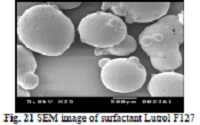Dissolution Rate Enhancement and Physicochemical Characterization of Artemether and Lumefantrine Solid Dispersions
Keywords:
Artemether, Lumefantrine, Solid dispersion, Melt method, Solubility, Dissolution rateAbstract
The current study was conceded out with a vision to enhance solubility and thereby dissolution rate of poorly water soluble Artemether [ARTM] and Lumefantrine [LUM] [BCSclass IV drugs] using Lutrol F127 as carrier surfactant. ItÊs difficult to choose a single carrier which forms solid dispersion [SD] with both the drugs by melt method. For which number of polymers and combination trials were carried out and finally Lutrol F127 was selected for further studies. SD was prepared by melt method using different ratios of drug and Lutrol F127. Saturation solubility study was conducted to evaluate the effect of polymer on aqueous solubility of ARTM and LUM. Solid state characterization was evaluated by fourier transformation infrared spectroscopy, differential scanning calorimetry, x-ray diffraction study and scanning electron microscopy. In vitro dissolution study was performed in phosphate buffer at pH 7.2 [with 1% SLS] and 0.1 N HCl [with 2% Benzalkonium chloride, BKC] for ARTM and LUM respectively. Solid state study showed partial interaction between drug and Lutrol F127. In vitro dissolution rate of ARTM and LUM from SD was significantly higher compared to pure drug. The dissolution rate of SD prepared by melt method was found to be higher than that of pure drugs and their physical mixtures. Thus, SD using melt method can be successfully used for the improvement of the dissolution rate of ARTM and LUM.
References
Juma E. A randomized, open-label, comparative efficacy trial of artemether-lumefantrine suspension versus artemether-lumefantrine tablets for treatment of uncomplicated plasmodium falciparum malaria in children in western kenya. Malaria Journal . 2008;7: 262-280.
Andriantsoanirina V. Resistance of plasmodium falciparum to antimalarial drugs: impact on malaria pre-elimination in madagascar. Med Trop [Mars]. 2011;1(3):298-304.
Artemether and lumefantrine tablets: the international pharmacopoeia document QAS/07.192/FINAL. 2008;1-5.
World Health Organization [WHO]. Guidelines for the treatment of malaria. 2006;
-266.
World Health Organization [WHO], international travel and health situation. 2009;1-250.
Ansari M. Physicochemical characterizations of artemether solid dispersion with hydrophilic carriers by freeze dried and melt methods. Arch Pharm Res. 2010;33 [6]:901-910.
Shah P. Development and evaluation of artemether taste masked rapid disintegrating tablets with improved dissolution using solid dispersion technique. AAPS PharmSciTech. 2008;9:494-500.
Yang B. Artemether/hydroxypropyl-b-cyclodextrin host–guest system: characterization, phase-solubility and inclusion mode. Bioorganic & Medicinal Chemistry. 2009;17:6311-6317.
Lee B. Enhanced bioavailability of poorly water soluble artemether using peg-based sd in rats, beagle dogs and human subjects AAPS annual meeting. Pharm Sci Suppl. 1999;4: 14–18.
Kim T, Shin J. Enhanced dissolution and bioavailability of poorly water soluble artemether using solid dispersion system. AAPS Annual Meeting. 2001;21–25.
Gowda K, Rajan D. Evaluation of bioequivalence of two formulations containing 100 mg of artemether. Drug Dev Ind Pharm. 2006;32:19–25.
Maulvi F. Improvement of dissolution rate of aceclofenac by solid dispersion technique. Powder Technology. 2011;207 (1–3):47–54.
Liversidge E, Liversidge G. Nanosizing: a formulation approach for poorly water-soluble compounds. Eur J Pharm Sci. 2003;18:113-120.
Chiou W, Riegelman S. Pharmaceutical applications of solid dispersion systems. j pharm sci. 1971;60:1281-1302.
Preetham A. Formulation of a poorly water-soluble drug sirolimus in solid dispersion to improve dissolution. Journal of Dispersion Science and Technology. 2011; 32:778–783.
Higuchi T, Connors K. Phase-solubility techniques. Adv Anal Chem Instrum. 1965;4: 117–210.
Rasenack N, Muller B. Development of novel ibuprofen-loaded solid dispersion with improved bioavailability using aqueous solution. Arch Pharm Res. 2002;19:1894-1903.
Rasenack N, Hartenhauer H. Microcrystals for dissolution rate enhancement of poorly water-soluble drugs. Int J Pharm. 2003;254:137-145.
César Costa I. Quantitation of artemether in pharmaceutical raw material and injections by high performance liquid chromatography. Brazilian J Pharm Sciences. 2009,45:737-742.
Khalil I. Measurement of lumefantrine and its metabolite in plasma by high performance liquid chromatography with ultraviolet detection. J Pharm & Biomed Anal. 2011, 541: 68–172.
Leuner C. Improving drug solubility for oral delivery using solid dispersion. Eur. J. Pharm. Biopharm. 2000, 50:47–60.
Narayankar S, Phadke M. Development of discriminating dissolution procedure for artemether and lumefantrine tablets. Der Pharma Chemica. 2010, 2[5]:494-499.
Vasconcelos T, Sarmento B. Solid dispersion as strategy to improve oral bioavailability of poor water soluble drugs. Drug Discovery Today. 2007, 12: 1068-1075.





